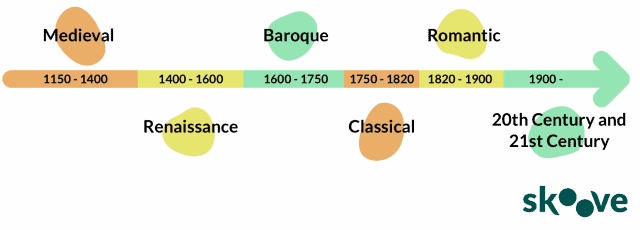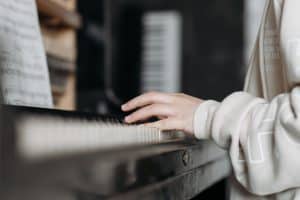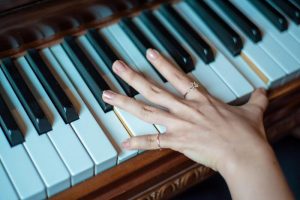Classical music is all around us. We hear it in supermarkets, restaurants, films, television adverts, and in so many more places. From the monastic monks’ chants of medieval Europe to Chopin’s strikingly beautiful piano melodies; from the elegance of Mozart to the film music of Star Wars, classical music has influenced life for centuries and will continue to do so for countless more. All the aforementioned music sounds very different, and so it can be helpful to divide it into categories – what we call periods, or eras, of music history.

Different eras of classical music and how accurate are the date ranges?
The 7 eras of music are categorized as Medieval (1150–1400), Renaissance (1400–1600), Baroque (1600–1750), Classical (1750–1820), Romantic (1820–1900), 20th Century (1900–2000) and Modern (2000–current). The diagram below shows the music time periods in order

In reality, many composers from these classical music time periods fit into more than one of these categories. That’s because – like all labels for periods of history – terms like ‘ Classical’ or ‘Romantic’ don’t simply represent a given number of years but rather the beliefs and attitudes of certain people. So it’s better for you to think of these different eras of music as a rough guide rather than an exact set of dates.
What is medieval era music?
The medieval period of music dates from around 1150–1400.
Medieval music characteristics
Most medieval music came from the growing influence of the Catholic church in Europe. Therefore, medieval-period music is predominantly religious; furthermore, much of it was not written down and was performed as part of monastic life, being passed down the generations aurally. Learning all the music of your monastery from memory was part of daily life for the monks; even today,memorizing music can be an extremely useful skill for pianists to develop.
Of the music that was written down, some of the manuscripts from this era are incredibly beautiful and were copied out with amazing care and patience, even incorporating different colored inks.
Medieval music songs and composers
Typical instruments of the medieval period include the flute, recorder, and some plucked instruments such as the lute, but by far the most important and influential medieval-era music is Gregorian Chant – named after Pope Gregory the Great (c540–604), who was probably responsible for having all the chants collected together. These chants were monophonic (meaning a single, unaccompanied voice) and an important characteristic of medieval music. Polyphonic music (that is, when you have several musical parts occurring together) also developed around this time. The video below gives you an idea of what these Gregorian Chants sound like:
Although much medieval music is not attributed to anyone, some of the most important composers of this musical time period include Guillaume de Machaut, John Dunstaple, and Hildegard von Bingen – the first great woman composer.
What is the renaissance music era?
The renaissance music period dates from about 1400–1600.
Characteristics of renaissance music
While religious music continued to flourish during the renaissance period and composers remained focused on choral music, an important difference from medieval music is a greater use of polyphonic textures andharmony in music. New musical forms such as masses, motets, and anthems appeared, and secular music (meaning non-religious music), most notably madrigals and courtly dance music, flourished in the renaissance era. Indeed, even the English King Henry VIII was a composer of dance music – listen to ‘Pastime with Good Company’ on the video link below to hear one of the King’s composition:
The renaissance period allowed for increased musical expression and more individualistic compositional styles, so the music sounds a lot sweeter and fuller than medieval music. Other characteristics of renaissance music include a richer texture in four or more parts, a greater concern over piano chords and harmony, and the start of a shift from writing music in modes towards a system ofmajor and minor keys. Instruments heard in renaissance music include the lute, viol, crumhorn, rackett, and the sackbut (a predecessor of the trombone); some of these were so loud that they were mainly intended for use outdoors!
Renaissance music composers
Prominent renaissance music composers include William Byrd, Orlando Gibbons, John Dowland, and Thomas Tallis.
Several centuries later saw an intellectual and cultural revival of African American music known as the Harlem Renaissance, which spanned the 1920s and 1930s. Here, an energetic, fast-paced style of jazz music, along with slower, deeply emotionalblues music, filled the streets of Harlem, New York City, and led to greatjazz artists such as Louis Armstrong, Duke Ellington, Cab Calloway, and Miles Davies finding fame. Let’s check out the differences between jazz piano vs classical piano․
What is the baroque music era?
The baroque music period dates from about 1600–1750.
Baroque period music characteristics
It was during the baroque era that the idea of writing music in a particular key (like C major or A minor) really took hold. The baroque period grew out of Italy with the invention of opera and a new focus on a clear declamation of the words in a piece of vocal music.
But what is baroque music? During this period, vocal music no longer reigned supreme, and composers turned to writing instrumental works for varying combinations of instruments. Other highly significant baroque music characteristics are a greater emphasis on the clarity of rhythm and pulse, and more composers writing pieces of music for orchestra.
The increased demand for musical instruments resulted in an array of technological developments – entirely new instruments such as the oboe, bassoon, and fortepiano (predecessor of the modern piano) were invented, while stringed instruments of the renaissance period were replaced with the more powerful violin, viola, and cello. The harpsichord especially flourished, and percussion instruments like timpani, snare drum, and bass drum were added to the orchestra.
Baroque classical music and composers
The baroque period was dominated by the works of Johann Sebastian Bach, whose music is renowned for its complexity and intricate harmonies, and George Frederic Handel, who particularly excelled at writing grandiose ceremonial music as well as hugely popular operas. A fine example of Handel’s talent for writing ceremonial music is the Water Music, composed for King George I’s journey on the royal barge along the Thames in 1717.
What is the classical music time period?
The classical music period dates from about 1750–1830.
Classical period music characteristics
The classical period saw the development of many ideas coming out of the baroque era, along with new musical forms such as the concerto, symphony, sonata, trio, and quartet. A particularly important change was the replacement of the harpsichord with the piano. The late eighteenth century resulted in some of thebest classical piano songs ever to have been written. Orchestras grew in size and range, and even more importance was given to instrumental music as a whole. The main characteristics of classical period music were an emphasis on beauty, elegance, rationality, order, and balance, and a decidedly less complicated musical texture than that of the baroque period. Find more about the characteristics of classical music inclassical piano vs pop piano article.
Central to the music of the classical period is a definitive sense of structure and form, with clear-cut phrases and clearly marked cadences. Classical composers liked to communicate clearly to their audiences and wanted them to be able to grasp the way the music was written. This meant that they all used the same structures for pieces of music, the same sorts of melodic and harmonic conventions, and the same ideas about when musical ideas started, finished, or veered off in unexpected directions. So classical-period music was largely a shared experience between composer, performer, and audience.
Classical period music and composers
The most important composers of the classical era all spent most of their lives in the Austrian capital Vienna. Wolfgang Amadeus Mozart was arguably the greatest composer of the period. There are many famous Mozart pieces, although this title could just as easily be awarded to his contemporaries such as Joseph Haydn, Ludwig van Beethoven, and Franz Schubert. If you want to learn some quintessential music from the classical era, try out Mozart’s ‘Eine kleine Nachtmusik’ on the Skoove App.
Learn how to play ‘Eine Kleine Nachtmusik’ by Wolfgang Amadeus Mozart. Start a 7 day trial today – no card details required!
Author of this blog post:

Sam Girling is a percussion and piano teacher, writer, an researcher based in Münster, Germany and Auckland, New Zealand. He has performed extensively in New Zealand and Europe, lectures on a variety of music history and theory topics, and has published several academic articles and musical scores. Sam has taught music in a variety of contexts, from primary schools through to university level.















